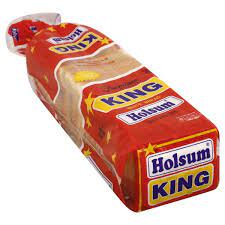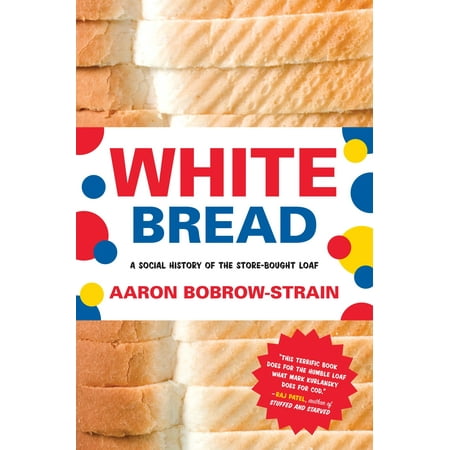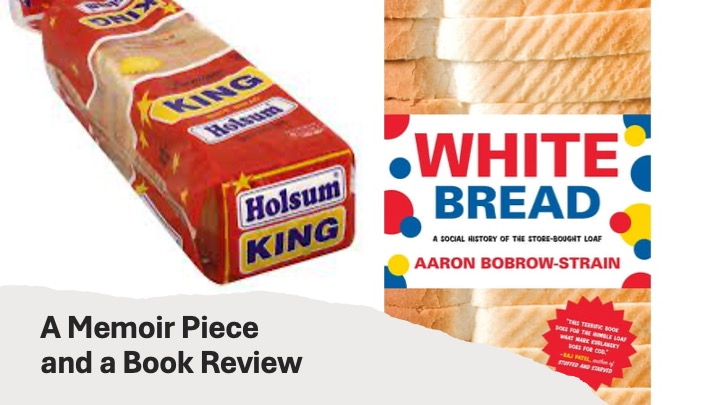Aaron Bobrow-Strain, White Bread: A Social History of the Store-Brought Loaf (Boston: Beacon Press, 2012), 252 pages include an index and extensive notes.
A story from my bakery days

In a supervisor meeting sometime in 1979 or 1980, Jerry Hendrix, the General Manager of Fox Holsum Bakery, berated us for not being able to produce uniformed loaf bread. “I don’t care if it’s crap,” he said. “It needs to be consistent. If it’s consistent, I can sell it.”
It was a tough time for bakeries. To start with, our government sold an excessive amount of wheat to Russia, who were dealing with poor harvests. The price of flour had doubled, cutting deeply into our profit margins. Furthermore, the price of sugar had gone up as had the cost and availability of natural gas. We were being squeezed from all directions. And now, our number one product, a pound and a half loaf of white bread was becoming unmanageable. Most of us felt that the problem came from the yeast. A few months earlier, we have left behind Fleishmann’s Yeast” for a new company’s product, “Dixie Yeast.” At first, things ran fine. The yeast still worked fine on our variety bread and on the roll line, which used traditional mixing equipment with chilled jackets.
The white bread line was different. This bread was mixed in a do-maker. This machine that mixed the ingredients at a very high rate of speed and a high temperature. The fermentation was first done in large vats that consisted of water, sugar, yeast, and other dough conditioners. Flour, along with shortening and sugar (corn syrup) were added straight into the mixer, along with the brew from the vats. The bread was cut into a piece of dough and dropped into a pan. Such rough treatment of the dough required not only chemical treatment, but also demanded ingredients to be constant. We produced 4200 loaves an hour of this bread. But each vat of bread rose differently. Sometimes the bread was too large, making it hard to slice and bag. Other times, the loaf was too small, and looked sick.
The General Manager and the company’s owners didn’t want to hear our excuses about the yeast. Sometime around this point, we learned the owners of the bakery had, with other industrial bakers, invested in the yeast company. A host of specialists were brought in. They tried new kinds of chemical dough conditioners, but nothing works. The decision was made to go back to Fleishmann’s yeast. Things returned to normal. After a lot of checking, we learned that the yeast was being mixed in fiberglass tanks instead of stainless steel. The fiberglass tanks were harder to clean (but they were cheaper). Eventually they had to change out their production tanks. A few months later, we went back to Dixie yeast, and it worked fine.
My review of White Bread

I tell the above story to illustrates a lot of what Aaron Bobrow-Strain writes about in his social history of white bread. Bleached, chemically enhanced bread has always been suspect. But by the 1950s, Americans ate an average of eight slices a day of the stuff. By the late 70s, when I worked in an industrial bakery, the decline of such bread was on the horizon. In another production meeting, at a time of high inflation, we heard warnings that if a loaf of bread rose to cost more than a dollar, it would doom our industry. People, we were told, would never pay so much for bread. I often think of this when I spend four dollars on a loaf today.
While bread might seem to be an odd research topic for a social history, but Bobrow-Strain provides an interesting insight into the rise of the loaf, and its decline. He also provides insight into other issues going on in America (and to lesser extent Europe and the rest of the world) during the rise of industrial baking. In 1890, 90% of the bread consumed in the United States was baked in a home kitchen. By 1930, during the depression, this completely reversed. 90% of the bread was baked in industrial factories.
The rise of factory produced bread is a compelling story that often reflects American prejudices and biases. Prior to the rise of industrial baking, most of the commercially available bread were baked in basement shops in cities like New York City. Here, in these bakeries, immigrants lived and worked in less than sanitary conditions. The first industrial bakeries jumped on American nativism feelings to promote their product as wholesome and clean. In addition, as technology changed, they were able to purchase ingredients much cheaper than the small local bakeries or even housewives. With the increase of transportation options, industrial bakers were in the position to seize the bread markets.
White bread ruled the day, but there were some who questioned this including blaming the fall of France to Germany in 1940 on white bread. French bread is white (but not necessarily industrially produced), while the Germans preferred a darker bread. Later, in the Cold War, American’s felt their “white bread” was superior to Russian dark loaves.
Advertising encouraged consumers to equate the softness of the new industrial bread with freshness, overlooking the use of chemicals to condition the dough. Interestingly, at the dawn of America’s entry into World War II, a significant number of American men did not meet the physical demands for military service. Processing of the flour to produce the whitest loaves robbed the wheat of essential vitamins. But such enrichments could be added back chemically. The first national food order during the war required such enrichments. By the end of the war, no one wanted anything less that “enriched” bread.
Throughout the fifties’, people considered enriched bread a superfood. It even caught on in places like Japan. When I visited Japan in 1979, it was shocking to see on the shelves white bread void of crust! By the 60’s, the hippie counter cultural laid groundwork for a rediscovery of bread baked at home or in small shops. Newspapers ran recipes about home baking and cookbooks sprang up included the Tassajara Bread Book. I discovered this book while working at the bakery and used (and still use) the recipes in the book to make heartier loaves of bread.
Bakers began to respond by adding more bran and even adding cellulous (wood pulp) to increase the fiber within bread. One of our variety breads was “VIM” in which we added a couple 50 pounds of bags of cellulous to each mixer. I recall it making the dough sticky and almost as hard to machine as rye bread. Another trick was to add sourdough flavoring to the mix to make the bread taste a little more like sourdough bread, which required a two-step mixing process and allowing the “starter” to proof, which took up space and equipment.
Bobrow-Strain ends his story with how white bread, once seen as food for the wealthy and royalty, became equated with “white-trash” and even soul food. Unlike the 70s, today’s bread aisles in supermarkets carry a variety of bread. We now eat bread with more grains or whole wheat that the industrial white bread which I made during my baking years.
Toward the end of the book, Bobrow-Stain takes us inside Grupo Bimbo, the largest baking company in the world today. Oddly enough, it is a Mexican company who has taken over many of American top bakery labels. I still remember the first time I saw “Bimbo Bread,” which was in Honduras in 2004. Why would anyone use such a label for product, I wondered. Of course, I thought of the word in its negative American slang connotation. In Latin America, Bimbo is the name of a bear mascot.
Conclusion
While I enjoyed this book, I know it appealed to me because of my background in a wholesale bakery. But there is much to learn here, so I recommend it to others. Bobrow-Strain even moves outside of bread to discuss our attempts to “eat healthier” and how Americans (since Sylvester Graham in the early 19th Century) have followed food gurus who promised great things but often failed to deliver. The book is worthwhile for this, alone, in a day in which we seem more susceptible to all kinds of claims that may have little scientific backing. The author also has a love of baking and eating good loaves of bread, so he’s writing about something for which he cares.


That book sounds really interesting! I eat white bread because that’s the only bread the 5-year-old will eat. I love all bread. I don’t think I’ve ever met a loaf I didn’t like. 🙂
Working in such a plant, I came to appreciate better quality bread (that which was made with a sponge method to create a bit of sour in the dough and a chewier type of bread).
Very interesting, Jeff. I can’t even think of eating sliced white bread though. It has never appealed to me. The more nuts, grains and texture bread has, the better I like it. Great post!
I would agree. I prefer bread that’s also chewy. The only white bread I eat is French bread, but that’s made with long fermentation times and sourdough, which gives it much more flavor than that mushy stuff we made.
I love microhistory food books. I may need to check this one out. Thanks for the review.
That’s a good sub-genre title, “microhistory food books”
We still eat about a loaf a week (though the dog gets his portion. The only reason I’d know it’s on the decline is because bread and bread products are harder to find in the stores.
We probably eat a loaf a week, also. But in the 1950s, the average person ate 8 slices a day (I assume that meant 2 pieces of toast for breakfast, 2 sandwiches/4 slices at lunch, and two slices with dinner). I don’t know of anyone eating that much bread today.
I worked in a deli/bakery for a couple of years back when I was a teenager. We made so much bread. It was fun though because we got to eat whatever we wanted. lol
did you knead bread or was it made in a mixer?
What a perfect book for you to read and review! I have to admit, I’ve never been a great fan of sliced white bread. We had a Colonial Bakery in town, so I’m sure that was what I ate growing up. These days, I buy 100% whole wheat.
Like you, I only eat whole wheat or heavily grained sliced bread. I will eat white French bread.
Yeast is so temperamental. I buy the same kind every time because every time I haven’t, I end up with flops.
I was always envious of my peers who ate sandwiches on white bread. It always looked so soft and delicious compared to the homemade breads my mom made. Now, I’m not even sure my kids have ever seen white bread as mostly what the stores carry in our area are wheat versions.
It is amazing, as I remember seeing bread other moms make and thinking they looked good (and we ate the white sandwich bread). Later, my parents only ate rye.